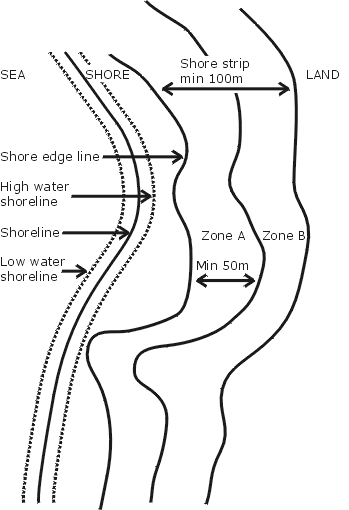Regulatory tools
Regulations determine what is and what is not allowed
concerning activities in the coastal zone. Regulations
are used where marked mechanisms are absent or weak. Examples
are: you may not build a house on the beach, you may only
dump your garbage on the official rubbish dump, and, recreational
fishing is allowed at a minimum cross-shore distance of
100m from the mean low water line. For the application
of regulations, one should keep in mind that:
- regulations should be used in the most cost-effective
and environmentally most advantageous way. Think about
the possible regulations and choose "the best"; and,
- regulations must be enforced. This means that the
subject of the regulations must be monitored (How
much do they actually pollute?) and in case of an
offence permits should be withdrawn (Close the polluting
plant!) or fines charged.
Zonation is a spatial planning tool which divides
a geographic area in several zones and designates particular
uses to each. The zones may be determined according to
risk for natural hazards, or according vulnerability of
the nature, or according to several user functions. An
example of Turkey is described in the adjacent text.
Set-back lines are lines parallel to the coast
seaward of which no construction of houses or other
buildings is allowed. The line is usually defined in
terms of a cross-shore distance from the active beach
or dunes.
Mitigation and substitution regulations are
necessary if the construction of certain buildings or
infrastructure is essential to a community or nation
(e.g., a storm surge barrier) and negative effects can
not be precluded. The negative effects must be mitigated
as much as possible and "substituting" coastal resources
must be created. The latter means that an area must
be created, or restored from a previously degenerated
one, which has similar or more natural resources as
the one that will be (partly) lost.
|
Example of zoning: Turkey

Cited from Ozhan96:
The law gives definitions of the 'shoreline' and the
'shore'. The 'shoreline' is defined as: 'the line along
which water touches the land at the shores of seas,
natural or artificial lakes, and rivers, excluding the
inundation periods'. The 'shore is the area between
the shoreline and the 'shore edge line', which is defined
as 'the natural limit of the sand beach, gravel beach,
rock, boulder, marsh, wetland and similar areas, which
are created by water motions in the direction of land
starting from the shoreline'. [...] The 'shore strip'
is set to have a minimum of 100m width horizontally,
starting from the 'shore edge line'. [Read
on]. |